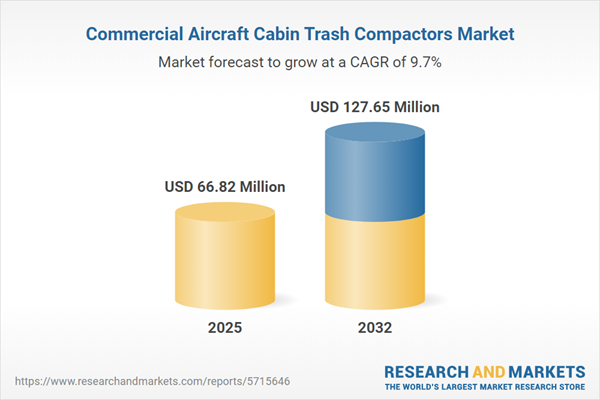Speak directly to the analyst to clarify any post sales queries you may have.
The commercial aircraft cabin trash compactors market is evolving rapidly, driven by airlines seeking to align operational efficiency with sustainability mandates and complex regulatory landscapes. As environmental expectations grow and cost optimization becomes critical, senior executives are re-examining their waste management strategies for enhanced compliance and performance.
Market Snapshot – Commercial Aircraft Cabin Trash Compactors Market
The commercial aircraft cabin trash compactors market demonstrated notable expansion, growing from USD 60.79 million in 2024 to USD 66.82 million in 2025. Market projections indicate it will reach USD 127.65 million by 2032, achieving a CAGR of 9.71%.
This momentum reflects a sector-wide effort to modernize waste management and improve operational outcomes. Airlines and their partners are investing in technology upgrades that assure safety while targeting stricter environmental goals. Innovation in compactor systems now emphasizes integrated solutions and flexible workflows to support differing operational environments and address evolving compliance standards. Suppliers are responding to this demand by offering high-performance systems engineered for a spectrum of global operators, focusing on operational adaptability, safety, and sustainability.Scope & Segmentation of the Commercial Aircraft Cabin Trash Compactors Market
This market analysis presents targeted insights for procurement and operational leaders seeking detailed understanding of solution categories, deployment areas, customer requirements, and regional trends that shape procurement and planning in the commercial aircraft cabin trash compactors market:
- Product Types: Electric compactors, hydraulic compactors, and manual compactors are tailored for varying airline use cases, providing seamless integration for both frequent use and specialized operational demands.
- Installation Areas: Solutions are designed for cabin, galley, and lavatory installations, optimizing space utilization and facilitating efficient waste processing for single-aisle and wide-body aircraft.
- Distribution Channels: Procurement options include original equipment manufacturers, authorized service centers, and independent service organizations, each contributing to comprehensive aftersales support and lifecycle management.
- Aircraft Types: Business jets, narrow-body and regional jets, as well as wide-body aircraft, require adaptable compactor solutions that match cabin configurations and variable waste volume needs.
- End Users: The end-user base spans cargo airlines, full-service and low-cost passenger carriers, defense and governmental aviation groups, as well as corporate and private charter operators, demanding solutions that align with diverse regulatory and operational frameworks.
- Regions: The Americas, Europe, the Middle East and Africa, and Asia-Pacific each bring unique regulatory considerations, adoption rates, and implementation challenges that influence supplier and buyer strategies.
- Companies Profiled: Safran S.A., RTX Corporation, Diehl Aviation GmbH, Jamco Corporation, Aernnova Aero Interiors S.L., TEAC Aerospace Solutions Inc., KID-Systeme GmbH, and Parker-Hannifin Corporation contribute proprietary technologies and a broad portfolio of solutions across the commercial segment.
Key Takeaways for Senior Decision-Makers
- Modern trash compactor systems feature connectivity and digital monitoring, allowing airlines to enhance waste logistics and streamline overall operations at scale.
- Technological innovation focuses on modular and lightweight designs, making maintenance simpler and supporting sustainability, especially during upgrades or aircraft retrofits.
- Procurement strategies are shifting toward dual sourcing and local supplier relationships, strengthening operational resilience and ensuring service continuity in unstable or shifting market conditions.
- Regional market dynamics shape technology adoption: North America prioritizes robust support infrastructure, Europe and the Middle East require strict compliance, and Asia-Pacific aligns upgrades with rapid fleet expansion.
- Improving the passenger experience continues to drive compactor system advancements, fostering better integration with cabin services and supporting emerging cabin management requirements.
Tariff Impact
Forthcoming tariff changes anticipated from 2025 are prompting many airlines and service firms to reevaluate sourcing and supply chain models. A potential rise in import expenses is increasing the reliance on local and dual-source partners and strengthening in-region repair and support networks. These strategic shifts are aimed at ensuring procurement continuity and supporting flexible responses to ongoing global trade fluctuations.
Methodology & Data Sources
Findings in this analysis are based on direct interviews with aircraft equipment manufacturers, leading airline maintenance professionals, systems integrators, and regulatory authorities. Supplementary data derives from technical documents and regulatory reports, with all insights verified through value chain mapping and trend analysis to ensure reliability.
Why This Report Matters
- Enables senior leaders and procurement managers to make informed decisions backed by specialized market intelligence, aligned with current sustainability goals and compliance needs.
- Supports benchmarking of suppliers and identification of opportunities, reducing operational and supplier risk across global diversified fleets.
- Offers actionable insights to optimize procurement, strengthen supply chain adaptability, and support the evolving requirements for next-generation aircraft cabin waste systems.
Conclusion
The commercial aircraft cabin trash compactors market is being reshaped by changing regulatory demands and sustainability targets. With focused market intelligence, decision-makers are positioned to guide future-ready strategies in a rapidly shifting aviation sector.
Additional Product Information:
- Purchase of this report includes 1 year online access with quarterly updates.
- This report can be updated on request. Please contact our Customer Experience team using the Ask a Question widget on our website.
Table of Contents
3. Executive Summary
4. Market Overview
7. Cumulative Impact of Artificial Intelligence 2025
List of Figures
Samples

LOADING...
Companies Mentioned
The key companies profiled in this Commercial Aircraft Cabin Trash Compactors market report include:- Safran S.A.
- RTX Corporation
- Diehl Aviation GmbH
- Jamco Corporation
- Aernnova Aero Interiors, S.L.
- TEAC Aerospace Solutions, Inc.
- KID-Systeme GmbH
- Parker-Hannifin Corporation
Table Information
| Report Attribute | Details |
|---|---|
| No. of Pages | 197 |
| Published | October 2025 |
| Forecast Period | 2025 - 2032 |
| Estimated Market Value ( USD | $ 66.82 Million |
| Forecasted Market Value ( USD | $ 127.65 Million |
| Compound Annual Growth Rate | 9.7% |
| Regions Covered | Global |
| No. of Companies Mentioned | 9 |









